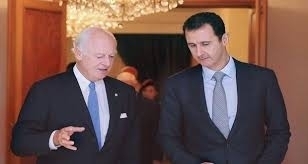I cannot understand United Nations Special Envoy for Syria Staffan de Mistura’s plan for resolving the Syrian crisis, the leaks of which have recently been published. The leaked plan suggests there are two contradictory projects being considered as part of one package: a regime ruled by Bashar al-Assad and areas ruled by armed opposition groups; all of whom would agree to stop fighting for two years.
I am not certain that my analysis is 100 percent correct, as some of the details may be intentionally ambiguous so that solutions can be drawn up according to each party’s ability to make concessions at a later stage. To reduce the ambiguity, we will assume there are four readings of de Mistura’s project, in light of the reality on the ground in Syria today. His idea suggests the solution is one where power in Syria is decentralized given the myriad of players in the conflict and the diminishing presence of the regime on the ground. As a result, the plan suggests that each party would continue to rule the areas they presently control.
The first interpretation would see Assad remain as president in Damascus but would open the government up to opposition participation. Assad’s authority, however, would be limited to whatever areas he still controls in Syria while the Free Syrian Army would continue to manage its areas and other belligerent parties would manage theirs. Of course, terrorist groups—such as the Islamic State of Iraq and Syria (ISIS), the Nusra Front, and Ahrar Al-Sham—would be excluded from this partnership. This means that the regime and the opposition must not only accept Assad staying in power, but they must also ally with him to fight against terrorist organizations. If my interpretation is correct, I would tell de Mistura to keep watching Hollywood movies, as they are closer to reality than this far-fetched proposal.
My second reading is that the plan calls for making concessions and setting the minimum of acceptable demands. In this scenario, Assad would exit power and a hybrid administration consisting of the remains of the current government and the moderate opposition would be formed, and each party would continue to control the areas it currently oversees. This interpretation is closer to what was proposed at the Geneva I conference, but it does not foresee a centralized government. Although this solution carries within it the seeds of dispute, it’s a relatively reasonable formula. However, Assad will refuse to leave power.
The third reading is that the plan calls for concessions to be made but without forming a joint government, in addition to a two-year ceasefire. The Assad regime would thus remain in power but without Assad himself, and his successor would govern Damascus. This solution would make all parties feel as though they have won, albeit partially.
The last possibility—and I’m afraid this is the most likely one—is similar to the third one in terms of freezing the situation for two years with a truce. This solution, however, would see the same regime and the same president stay in power. Meanwhile, the opposition would run its own areas but would not be allowed to arm itself, all the while the regime would be repairing its broken army and refilling its warehouses with ammunition.
De Mistura’s suggestion in the latter case is similar to the Israeli solution for the Palestinian territories: a local administration submissive to the enemy! Just like the first interpretation, most open-minded and moderate opposition parties would reject it, and anyone who agreed to such a plan and signed up to it would be killed on his doorstep.
It seems to me that all possibilities are inspired by the case of Somalia. The African country of Somalia has divided as a result of domestic fighting and ended up without one single regime and lacks a centralized government. The situation has been left to stagnate due to the presence of some 10 squabbling factions.
If de Mistura insists on promoting the idea of a truce without concessions, this will mean extending the regime’s rule for two more years. We smell an Iranian-like scheme here. Since the beginning, playing for time has always been the scheme of Assad and his Iranian ally. In the summer of 2011, i.e. around five months after the anti-Assad revolution erupted, the Syrian president promised to adopt Turkish suggestions for reform and promised Ankara that he would carry out political reform to end the peaceful protests calling for his removal. However, everyone later found out that this was a mere trick to begin mass murder operations.
In the spring of 2012, Assad promised the Russians that he would end the revolution in two months if they supported him. He thus involved them in the war and actually lost more than he gained. Last year, he resorted to using foreign militias and groups from Iran, Hezbollah, and other groups from Iraq, thinking this would help him to achieve qualitative and quantitative victory. His supporters cheered this move, but a year and a half later, the opposition continues to besiege him and is still capable of blocking the airport road in Damascus itself. What’s worse is that chaos erupted and the monster that is ISIS surfaced.
Therefore, the passage of time has been something that has worsened the situation for Syria and the world. Now de Mistura is suggesting a two-year truce which might mean keeping Assad in power. He’s thus repeating the Iranian idea of buying the Syrian regime time to strengthen itself. The trick is that instead of the opposition paying attention to the time factor, they will be preoccupied with territorial details and with issues of governance, without resources or arms to fight their enemy.
...


